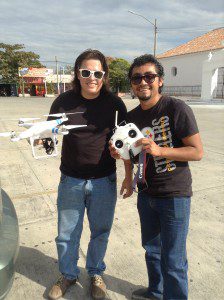
Drones are simply flying cameras, which can provide fantastic aerial photos and video footage. I recently tested out the Phantom 2, one of the most popular drones currently available to consumers. I was keen to better understand its educational value.
I first encountered the Phantom 2 on a road trip in Guatemala over the Christmas holidays. Whilst briefly stopping off in the remote town of Rio Hondo, I happened to meet two Guatemalans who work as freelance photographers. The purchase of a drone turned out to be a turning point for their business because it meant that they could offer a premium service. The drone enables them to provide video footage from a myriad of vantage points in the sky, a really novel feature for wedding videos and photos. Having seen the drone in action, I was impressed and could see several uses for this technology in school.
Our school bought the Phantom 2 a couple of weeks ago. I tried it out with the help of one of our students who already had a Phantom 2 at home, and has thus become the school’s in house drone expert. The Phantom 2 is remote controlled and can be connected to a range of tablet devices. Using the DJI app that can be installed on iOS or Android, you can view, in real-time, what the camera is looking at when it’s 300 feet in the sky. The app also allows you to tinker with camera’s settings including the field-of-view, as well as the quality of the video and still modes.
A quick overview of the Phantom 2 during our test flight at school:
I found the drone to be relatively easy to fly, but I did need the help of someone else to control the camera, which was done on an iPad via a WiFi connection. I was impressed with the fact that the drone self-stabilises. If you take your hands off the controls it’ll simply hover in its current position. There was also several moments where I lost sight of the drone, but thanks to the built-in GPS, the Phantom 2 automatically flies back to where it took off from. That being said, during the initial flight we found that the trees above were interfering with the GPS signal, the drone crashed and we needed to find a more open space. As a cautionary note, I would say that with safety in mind, this drone needs to be closely supervised by someone who has plenty of experience flying it. The Phantom 2 in particular, is also very noisy (a bit like a hornets nest) and this should be kept in mind if other lessons are going on nearby.
All of that said, after I’d seen the videos that the drone had taken, and I’d had time to reflect on its usefulness as an educational tool, I can say that there are several benefits to this technology. For one thing, it can get definitely get students excited about robotics and the possibilities such technologies provide. This could also promote discussion about some important issues surrounding privacy. The most important benefit in my opinion, however, is the aerial photo and video footage itself. By providing multiple birds-eye vantage points of the school community, this technology gives students a new visual perspective of their local area. An aerial photo of the school car park for example, could give 1st graders a basic data handling exercise (recording information about the colours of cars). For older students, aerial photos provide a range of opportunities for map work and geography related projects. At roughly $1,000, this is no small investment. As long as this technology is well-supervised and used appropriately though, the Phantom 2 has the potential to enhance lessons and improve learning outcomes.



